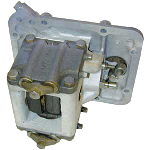 |
|
1. Bobbing implements a. This condition may be due to maladjustment of the main control spring or to a binding in the hydraulic control linkage. b. Adjusting the main control spring. NOTE: To explain how to adjust the main control curing, follow the procedure as outlined under job Procedure, Point I, in the Job Plan.
2. Mechanism will lift implements only at high engine speeds. a.. This condition is usually due to (1) The quadrant assembly being out of adjustment. (2) The constant draft spring set too short. b. Adjusting the quadrant assembly. NOTE: To explain how to adjust the quadrant assembly, follow the procedure as outlined under job Procedure, Point III, in the Job Plan.
c. Adjusting the constant draft spring. NOTE: To explain how to adjust the constant draft spring, follow the procedure as outlined under job Procedure, Points IV and V, in the Job Plan.
3. Implement raises and lowers in transport position. a. This condition may be caused by one or all of the following: (1) Binding linkage. (2) Scored ram cylinder. (3) Leak in the hydraulic pump.
4. Implement position control in‑operative. a. This condition is usually caused by the implement position control spring being too short. b. Adjusting the length of the implement position control spring.
NOTE: To explain how to adjust the length of the implement position control spring, follow the procedure as outlined under job Procedure, Point VI, in the Job Plan.
5. Constant draft control does not engage properly. a. This condition may be corrected by correctly adjusting the main control spring as previously explained.
6. Complete range of touch control inoperative. a. This condition may be due to (1) Improper setting of the quadrant support plate. (2) The constant draft control spring set too short.
|